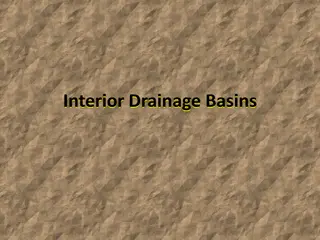Overview of Indian River Systems: Himalayan and Peninsular Drainage
The Indian river system is classified into two major categories - the Himalayan drainage system and the Peninsular drainage system. Himalayan rivers are predominantly perennial, younger, and more active, while Peninsular rivers tend to be more seasonal and older. Both systems have unique characteristics in terms of erosion, transportation, and navigability. Key rivers like the Indus and the Ganga have significant lengths and sources in the Himalayas. Various dams and projects also contribute to water management and power generation in the region.
Download Presentation

Please find below an Image/Link to download the presentation.
The content on the website is provided AS IS for your information and personal use only. It may not be sold, licensed, or shared on other websites without obtaining consent from the author.If you encounter any issues during the download, it is possible that the publisher has removed the file from their server.
You are allowed to download the files provided on this website for personal or commercial use, subject to the condition that they are used lawfully. All files are the property of their respective owners.
The content on the website is provided AS IS for your information and personal use only. It may not be sold, licensed, or shared on other websites without obtaining consent from the author.
E N D
Presentation Transcript
COMPILED By Mr. S.A.Patil Asst. Professor, Dept. of Geography, The New College, Kolhapur M.A.,B.ed.SET
The Indian drainage system is divided into two river system 1. Himalaya drainage system 2. Peninsular drainage system
Himalayan Peninsular These are perennial Rivers are mostly younger These are more active Rivers are mostly navigable Rivers are swift in their upper course These are seasonal Rivers are as old These are in term of erosion, trans. Depo. Rivers are generally navigable Rivers are slow moving
TYPES OF RIVERS Himalayan Rivers Peninsular Rivers
River Indus Source Mt. Kailash near Manas Sarovar Length Total 2880km & 709km in India 774km Information Ladakh and Zanskar range Arabian Sea Jhelum Spring of Verinag Srinagar, Wular Chenab Lahul HP 1180km Chabdra Bhaga Bara lacha Pir Panjal Beas Kangra HP Rohtang pass 470km Rahtang Pass Meet Sutlej at Hari ke Pattan Amritsar Sutlej Lake Rakshatal in Tibet near Manas 1550km Red river Shipki la HPMeet Beas Pattan Ravi Kangra HP Rohtang Pass 720km Rohtang pass Pir PanjalDhauladhar range
Baglihar project on R. Chenab in Doda District Kashmir ,Others are Salal, Dulhasti,Sawalkot, Kirthal Pakal Dul dams Mangla Dam on Jhelum rivr is the 6th largest dam in the World Chamera dam, Baira Siul Ranjeet Sagar dam on Ravi Bhakara Nangal Nathpa dam on Sutlej Pong dam Pandoh on Beas
One of the major river in South Asia It is 2900km long It is rises from the glaciers near Manas Sarovar lake It enter India throuth a deep gorge near Namcha Barwa Left bank tributaries: Dhansiri,Kapili,barak Right bank tributaries: Subansiri, Jia Bhoraeli,Manas Sankosh Tista Raidak
River source length Information Ganga Gamukh glacier Uttrakhand 2510km Initially it is Bhagirathi, Alakananda at Devaprayag and from here as Ganga Enters the plain land from Hardwar Yamuna Yamunotri glacier Utt. 1380km Meet ganga at Allahabad Chambal Malwa , Vindhyan 960km Meets Bhind (MP) Yamuna Ghagra Gurla Mandhata Meets Ganga at Chhapra Gandak Between Dhaulagiri & Mt. Evrst. Sonpur near Patna Son Amarkantak 780km Bankipura Patna Kosi Mt . Everest 729km Enters India Chhatra & saharsha Dis. Bihar Damodar Chandwa village Jharkand 592km Meets Ganga Falta
Bansagar dam & Indrapuri Barrange on Son Gandhi Sagar, Rana Praap Sagar Jawahar Sagar on Chambal Tehri dam on Bhagirathi Farakka on Ganga Panchet on Damodar
River source length Information Vriddha Ganga purna , maner penganga pranhita, largest delta in India Kolleru lagoon Godavari Brahmagiri , Trimbakeswar Nasik 1465km Krishna Mahabaleshwar 1290km Bhima Dindi Musi Ghataprabha, Tungabhadra Panchganga koyna ,bird foot delta Cauvery tapi Kodagu Karataka Satpura (MP) 765 700km Ganga of South Mah. MP, Guj,Purna Girna Panzara Narmada Amarkantak MP 1300km It flows through a rift valley
Doleshwar ,sriram sagar ,polavaran,trimbakeswar jayakwadi on Godavari Joorala Nagarjuna alamatti srisailam on Krishna Bargi ,kolar,omkareshwar ,sardar,indira sagar on Narmada























